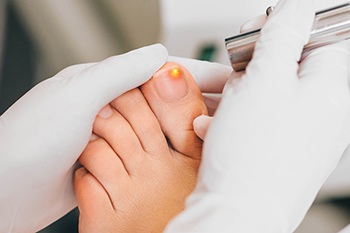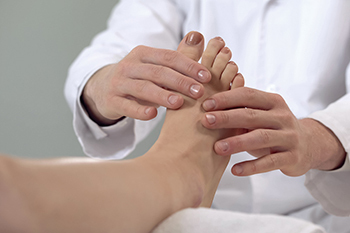NJ (908) 688-5577
NY (212) 737-2528

Laser treatment for toenail fungus is an advanced method that uses focused light beams to target and eliminate fungal infections beneath the toenail. This non-invasive procedure penetrates the nail without damaging surrounding tissues, making it a preferred option for many patients. Unlike traditional treatments, such as topical creams or oral medications, laser therapy has minimal side effects and a higher success rate. The procedure is typically quick, often completed in under an hour, and requires no downtime, allowing patients to resume normal activities immediately. Multiple sessions may be needed for optimal results, depending on the severity of the infection. Laser treatment is effective for many individuals, offering a promising solution for persistent toenail fungus, especially for those who have not responded well to other treatments. Toenail fungus can be unsightly, and is treated by a podiatrist. If you have this condition, it is suggested that you consult this type of doctor who can determine if laser therapy is right for you.
Laser treatment can be an effective way to get rid of toenail fungus. If you have any questions about laser treatment, consult with Glenn Davison, DPM from Advanced Podiatry. Our doctor will assess your condition and provide you with quality treatment for fungal nails.
What Are Toenail Fungal Infections?
Onychomycosis, or fungal infection of the nail, is a relatively common and non-serious condition. Around 10 percent of U.S. citizens are afflicted with fungal nails. Common forms of fungus that infect the nail include dermatophytes, yeasts, and molds.
Symptoms of Toenail Fungal Infections Include:
Diagnosis for Fungal Nails
Fungal infections are diagnosed by fungal culture and microscopy. This will rule out any other conditions such as nail trauma, psoriasis, lichen planus, and onychogryphosis.
What Is Laser Treatment?
Laser treatment is a non-invasive, safe, quick, and painless procedure that uses the heat from a laser to kill fungus in the nail. Each infected nail is targeted with a laser for several minutes. The treatment is usually utilized several different times over a select period. During this time, a podiatrist will keep an eye on the infection.
If you have any questions, please feel free to contact our offices located in Union, NJ and New York . We offer the newest diagnostic and treatment technologies for all your foot care needs.

A broken ankle, medically termed ankle fracture, poses significant risks and complications, particularly for active individuals and the elderly. Active individuals are often at risk due to participation in high-impact activities, while the elderly are susceptible due to factors such as decreased bone density and balance issues. One potential complication of a broken ankle is the development of osteoarthritis in the affected joint over time. This occurs due to the disruption of the joint's normal structure and function during the healing process, leading to cartilage degeneration and subsequent pain and stiffness. Elderly individuals, especially those with diabetes, are also prone to complications such as wound healing issues and infections, which can prolong recovery and increase the risk of further complications. Treatment for a broken ankle typically involves immobilization with a cast or brace and pain management. If you have sustained an ankle fracture, it is suggested that you schedule an appointment with a podiatrist who can provide comprehensive care, including monitoring for complications, optimizing rehabilitation, and providing long-term management for optimal foot health.
Broken ankles need immediate treatment. If you are seeking treatment, contact Glenn Davison, DPM from Advanced Podiatry. Our doctor can provide the care you need to keep you pain-free and on your feet.
Broken Ankles
A broken ankle is experienced when a person fractures their tibia or fibula in the lower leg and ankle area. Both of these bones are attached at the bottom of the leg and combine to form what we know to be our ankle.
When a physician is referring to a break of the ankle, he or she is usually referring to a break in the area where the tibia and fibula are joined to create our ankle joint. Ankles are more prone to fractures because the ankle is an area that suffers a lot of pressure and stress. There are some obvious signs when a person experiences a fractured ankle, and the following symptoms may be present.
Symptoms of a Fractured Ankle
If you suspect an ankle fracture, it is recommended to seek treatment as soon as possible. The sooner you have your podiatrist diagnose the fracture, the quicker you’ll be on the way towards recovery.
If you have any questions, please feel free to contact our offices located in Union, NJ and New York . We offer the newest diagnostic and treatment technologies for all your foot care needs.
 Foot pain can be debilitating, affecting daily activities and quality of life. Thankfully, several remedies can alleviate discomfort. Massaging the feet can help relax muscles and improve circulation, providing temporary relief. Custom orthotic inserts or wearing supportive footwear can provide long-term relief by correcting biomechanical issues and providing proper arch support. Stretching exercises can also improve flexibility and reduce muscle tension in the feet. However, if you have foot pain that persists or worsens despite these remedies, it is suggested that you seek professional help from a podiatrist who can diagnose the underlying cause of the pain and provide personalized treatment options.
Foot pain can be debilitating, affecting daily activities and quality of life. Thankfully, several remedies can alleviate discomfort. Massaging the feet can help relax muscles and improve circulation, providing temporary relief. Custom orthotic inserts or wearing supportive footwear can provide long-term relief by correcting biomechanical issues and providing proper arch support. Stretching exercises can also improve flexibility and reduce muscle tension in the feet. However, if you have foot pain that persists or worsens despite these remedies, it is suggested that you seek professional help from a podiatrist who can diagnose the underlying cause of the pain and provide personalized treatment options.
Foot Pain
Foot pain can be extremely painful and debilitating. If you have a foot pain, consult with Glenn Davison, DPM from Advanced Podiatry. Our doctor will assess your condition and provide you with quality foot and ankle treatment.
Causes
Foot pain is a very broad condition that could be caused by one or more ailments. The most common include:
Diagnosis
To figure out the cause of foot pain, podiatrists utilize several different methods. This can range from simple visual inspections and sensation tests to X-rays and MRI scans. Prior medical history, family medical history, and any recent physical traumatic events will all be taken into consideration for a proper diagnosis.
Treatment
Treatment depends upon the cause of the foot pain. Whether it is resting, staying off the foot, or having surgery; podiatrists have a number of treatment options available for foot pain.
If you have any questions, please feel free to contact our offices located in Union, NJ and New York . We offer the newest diagnostic and treatment technologies for all your foot care needs.

Golf, often perceived as a leisurely sport, can surprisingly pose risks of foot and ankle injuries, especially if proper precautions are neglected. One common cause of injuries is the repetitive motion of the golf swing, which can strain the muscles, tendons, and ligaments in the feet and ankles. Additionally, uneven terrain or poorly maintained golf courses can increase the risk of slips, twists, and falls, leading to sprains or fractures. To prevent foot and ankle injuries in golf, it is essential to prioritize proper warm-up exercises before hitting the course. Dynamic stretches targeting the lower body muscles can enhance flexibility and reduce the risk of strain during the swing. Wearing supportive golf shoes with ample cushioning and traction can provide stability and protect against injuries. It is also helpful to maintain good posture and technique while swinging can help distribute forces evenly across the body, minimizing stress on the feet and ankles. If you have endured a foot or ankle injury playing golf, it is suggested that you visit a podiatrist who can offer you treatment methods and injury prevention tips.
Ankle and foot injuries are common among athletes and in many sports. They can be caused by several problems and may be potentially serious. If you are feeling pain or think you were injured in a sporting event or when exercising, consult with Glenn Davison, DPM from Advanced Podiatry. Our doctor will assess your condition and provide you with quality foot and ankle treatment.
Common Injuries
The most common injuries that occur in sporting activities include:
Symptoms
Symptoms vary depending upon the injury and in some cases, there may be no symptoms at all. However, in most cases, some form of symptom is experienced. Pain, aching, burning, bruising, tenderness, tightness or stiffness, sensation loss, difficulty moving, and swelling are the most common symptoms.
Treatment
Just as symptoms vary depending upon the injury, so do treatment options. A common treatment method is known as the RICE method. This method involves rest, applying ice, compression and elevating the afflicted foot or ankle. If the injury appears to be more serious, surgery might be required, such as arthroscopic or reconstructive surgery. Lastly, rehabilitation or therapy might be needed to gain full functionality in the afflicted area. Any discomfort experienced by an athlete must be evaluated by a licensed, reputable medical professional.
If you have any questions, please feel free to contact our offices located in Union, NJ and New York . We offer the newest diagnostic and treatment technologies for all your foot care needs.